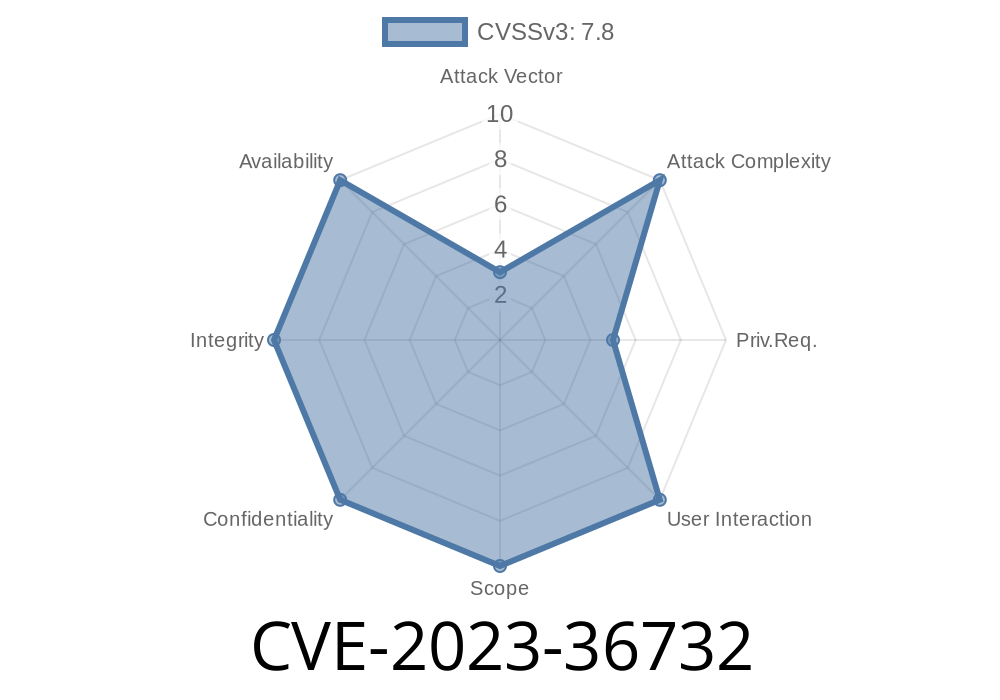In September 2023, Microsoft patched CVE-2023-36732, a critical Win32k Elevation of Privilege (EoP) vulnerability that puts Windows systems at risk. This post breaks down what CVE-2023-36732 is, how it works, and includes a simple code snippet to show the concept. We'll keep the language straightforward for all readers, and include references to trusted sources if you want to learn more.
What is Win32k and Why Should You Care?
Win32k.sys is a core system driver in Windows. It's responsible for window management, user interface (UI), and other graphics output. Since it's a kernel component, bugs in this driver can have severe consequences.
With an Elevation of Privilege (EoP) bug, a regular user could potentially gain system or administrator-level permissions. That's why vulnerabilities like CVE-2023-36732 are a hot target for attackers. Once exploited, attackers can bypass security controls and take full control of the victim machine.
Details on CVE-2023-36732
CVE-2023-36732 is a vulnerability in Windows' Win32k component that allows an authenticated, local user to gain higher privileges. Microsoft rates it as "Important" because, while it requires local access, it can lead to complete system compromise.
Patched on: September 12, 2023 (Patch Tuesday)
You can find the official Microsoft advisory here:
Microsoft Security Update Guide - CVE-2023-36732
What’s the Root Problem?
The flaw lies in improper input validation within the Win32k driver. Specifically, a regular user can cause the driver to perform kernel-level operations, leading to privilege escalation. The exact bug has not been made public by Microsoft (for security reasons), but security researchers say it’s related to window object manipulation.
How Could an Attacker Use It?
An attacker could write a local exploit program that interacts with the Win32k driver's functions—often using undocumented or poorly documented system calls. By crafting a malicious request, the attacker can execute code in the context of the SYSTEM account.
This can be chained with other attacks—such as phishing, remote code execution, or malware deployment—to gain persistent access.
Gain Access: The attacker logs in locally or through compromised credentials.
2. Trigger Vulnerability: By making special calls to the Windows API or directly to the Win32k.sys driver, the attacker causes unexpected behavior in kernel space.
Gain SYSTEM Privileges: The exploit elevates the attacker’s process to the highest level.
4. Control the System: Now the attacker can disable anti-malware, read/write files, install rootkits, or pivot further.
Simple Code Snippet (for Education Only)
Below is a basic example of how a simulated kernel exploit might look. This does not exploit CVE-2023-36732 (doing so would be illegal and unethical), but simply shows the skeleton of a privilege escalation approach using a vulnerable driver function.
#include <Windows.h>
#include <stdio.h>
int main() {
// Step 1: Open a handle to the vulnerable device (Win32k.sys)
HANDLE hDevice = CreateFile(
L"\\\\.\\Win32k", // Device name (for demo! Not real)
GENERIC_READ | GENERIC_WRITE,
,
NULL,
OPEN_EXISTING,
,
NULL
);
if (hDevice == INVALID_HANDLE_VALUE) {
printf("Device not found. Are you an admin?\n");
return 1;
}
// Step 2: Craft a malicious input buffer (demo, not actual exploit!)
char inputBuffer[100] = {};
DWORD bytesReturned;
// Step 3: Call DeviceIoControl to trigger the vulnerability
BOOL result = DeviceIoControl(
hDevice,
x222007, // IOCTL code (demo only)
inputBuffer,
sizeof(inputBuffer),
inputBuffer,
sizeof(inputBuffer),
&bytesReturned,
NULL
);
if (result) {
printf("Exploit attempt sent to driver.\n");
} else {
printf("Failed to send exploit.\n");
}
CloseHandle(hDevice);
return ;
}
Note:
- The above code won't work against real systems. It’s for educational purposes only—to show you what an EoP attack flow involving a kernel driver *could* look like. Never run code from random sources on your system.
Real-World CVE-2023-36732 Exploitation
As of this writing, public exploit code for CVE-2023-36732 is not available. However, security researchers such as Valentina Palmiotti track potential exploit paths and demonstrate similar kernel escalation bugs at conferences and in blog posts.
If you're curious about proof-of-concept codes, Twitter and GitHub are often where researchers first post them (when legal and ethical).
How to Stay Safe
Patch your system as soon as you can.
Microsoft's September 2023 updates fix this and several related bugs. Always enable automatic updates if possible.
Find the latest update here:
Microsoft September 2023 Security Updates
Final Thoughts
CVE-2023-36732 highlights that even trusted system drivers like Win32k.sys can be weak spots. Keeping your system up-to-date is the best way to stay safe from these and future threats.
Further reading & references
- Microsoft CVE-2023-36732 Advisory
- Zero Day Initiative - Vulnerability Snapshot
- Windows Kernel Exploitation Basics (i7c blog)
Timeline
Published on: 10/10/2023 18:15:17 UTC
Last modified on: 10/13/2023 19:28:13 UTC
